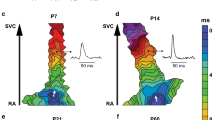Abstract
Background: The coronary sinus is a complex structure with a surrounding myocardial coat and muscle bundles that course within it. The purpose of this study was to evaluate the electrical activity of the coronary sinus (CS), great cardiac vein (GCV) and related structures, such as the Vein of Marshall (VOM).
Methods and Results: Data obtained from adult (n = 114) and pediatric patients (n = 16) were analyzed. The width of atrial electrograms (EGMs) within the CS at a basic pacing cycle length of 600 ms was 46 ± 7.4 ms (mean ± SD) vs. 29.7 ± 6.3 ms in the GCV (p < 0.01). With decremental pacing the width of the EGM within the CS at 300 ms increased to 66.6 ± 8.5 ms (p < 0.1 compared to CS EGM at pacing cycle length of 600 ms). The width of the EGM within the GCV increased from 29.7 ± 6.3 ms at a pacing cycle length of 600 ms to 34.6 ± 6.0 at 300 ms (p = NS). There were no significant differences in the atrial EGM width between CS and GCV in the pediatric patients.
Conclusions: We conclude that atrial electrograms are wider in the CS but not in the GCV. This finding can be explained by the presence of a myocardial coat around the CS. The rate response characteristics of the atrial electrograms within the CS are consistent with a lack of tight coupling between muscle bundles and the CS musculature. Further, the absence of such differences in pediatric patients could partly explain relative differences in types of supraventricular arrhythmias seen in different age groups.
Similar content being viewed by others
References
Ludinghausen MV, Ohmachi N, Boot C. Myocardial coverage of the coronary sinus and related veins. Clin Anat1992;5:1-15.
Kasai A, Anselme F, Saoudi N. Myocardial connections between left atrial myocardium and coronary sinus musculature in man. J Cardiovasc Electrophysiol2001;12:981-985.
Chauvin M, Shah DC, Haissaguerre M, Marcellin L, Brechenmacher C. The anatomic basis of connections between the coronary sinus musculature and the left atrium in humans. Circulation2000;101:647-652.
Antz M, Otomo K, Arruda M, Scherlag BJ, Pitha J, Tondo C, Lazzara C, Jackman WM. Electrical conduction between the right atrium and the left atrium via the musculature of the coronary sinus. Circulation1998;98:1790-1795.
Sun Y, Arruda M, Otomo K, Beckman K, Nakagawa H, Calame J, Po S, Spector P, Lustgarten D, Herring L, Lazzara R, Jackman W. Coronary sinus-ventricular accessory connections producing posteroseptal and left posterior accessory pathways: Incidence and electrophysiological identification. Circulation2002;106:1362-1367.
Olgin JE, Jayachandran JV, Engesstein E, Groh W, Zipes DP. Atrial macroreentry involving the myocardium of the coronary sinus: A unique mechanism for atypical flutter. J Cardiovasc Electrophysiol1998;9:1094-1099.
Enjoji Y, Sugi K, Tezuka N, Nakae T, Takami M, Sakata T, Noro M, Ikeda T, Yamaguchi T. Atrial double potentials associated with the elimination of the electrical connection between the coronary sinus (CS) and the left atrium in two cases of Wolff-Parkinson-White syndrome with a CSconnected accessory pathway. Jpn Circ J2000;64:793-796.
Hluchy J, Lautermann D, Sabin GV. Atrial double potentials associated with a left-sided accessory pathway having a single ventricular and two remote atrial insertions. Clin Cardiol1997;20:303-307.
Bubien RS, Fisher JD, Gentzel JA, Murphy EK, Irwin ME, Shea JB, Dick M 2nd, Ching E, Wilkoff BL, Benditt DG. NASPE expert consensus document: Use of i.v. (conscious) sedation/analgesia by nonanesthesia personnel in patients undergoing arrhythmia specific diagnostic, therapeutic, and surgical procedures. Pacing Clin Electrophysiol1998;21:375-385.
Meisel E, Pfeiffer D, Engelmann L, Tebbenjohanns J, Schubert B, Hahn S, Fleck E, Butter C. Investigation of coronary venous anatomy by retrograde venography in patients with malignant ventricular tachycardia. Circulation2001;104:442-447.
Kim DT, Lai AC, Hwang C, Fan LT, Karagueuzian HS, Chen PS, Fishbein MC. The ligament of Marshall: A structural analysis in human hearts with implications for atrial arrhythmias. J Am Coll Cardiol2000;36:1324-1327.
Doshi RN, Wu TJ, Yashima M, Kim YH, Ong JJ, Cao JM, Hwang C, Yashar P, Fishbein C, Karagueuzin HS, Chen PS. Relation between ligament of Marshall and adrenergic atrial tachyarrhythmia. Circulation1999;100:876-883.
Niebauer MJ, Daoud E, Williamson B, Man KC, Strickberger A, Hummel J, Morady F. Atrial electrogram characteristics in patients with and without atrioventricular nodal reentrant tachycardia. Circulation1995;92:77-81.
McGuire MA, de Bakker JM, Vermeulen JT, Opthof T, Becker AE, Janse MJ. Origin and significance of double potentials near the atrioventricular node. Correlation of extracellular potentials, intracellular potentials, and histology. Circulation1994;89:2351-2360.
Olshansky B, Okumura K, Henthorn RW, Waldo AL. Characterization of double potentials in human atrial flutter: Studies during transient entrainment. J Am Coll Cardiol1990;15:833-841.
Wit AL, Cranefield PF. Triggered and automatic activity in the canine coronary sinus. Circ Res1977;41:434-445.
Boyden PA, Cranefield PF, Gadsby DC, Wit AL. The basis for the membrane potential of quiescent cells of the canine coronary sinus. J Physiol1983;339:161-183.
Wit AL, Cranefield PF, Gadsby DC. Electrogenic sodium extrusion can stop triggered activity in the canine coronary sinus. Circ Res1981;49:1029-1042.
Hwang C, Wu TJ, Doshi RN, Peter CT, Chen PS. Vein of Marshall cannulation for the analysis of electrical activity in patients with focal atrial fibrillation. Circulation2000;101:1503-1505.
Chen PS, Wu TJ, Ikeda T, Ong JJ, Kim YH, Yashima M, Doshi R, Hwang C, Karagueuzin HS. Focal source hypothesis of atrial fibrillation. J Electrocardiol1998;31:32-34.
Oral H, Ozaydin M, Chugh A, Scharf C, Tada H, Hall B, Cheung P, Pelosi F, Knight BP, Morady F. Role of the coronary sinus in maintenance of atrial fibrillation. J Cardiovasc Electrophysiol2003;14(12):1329-1336.
Author information
Authors and Affiliations
Corresponding author
Rights and permissions
About this article
Cite this article
Cesario, D.A., Valderrabano, M., Cai, J.J. et al. Electrophysiological Characterization of Cardiac Veins in Humans. J Interv Card Electrophysiol 10, 241–247 (2004). https://doi.org/10.1023/B:JICE.0000026919.49412.93
Issue Date:
DOI: https://doi.org/10.1023/B:JICE.0000026919.49412.93




